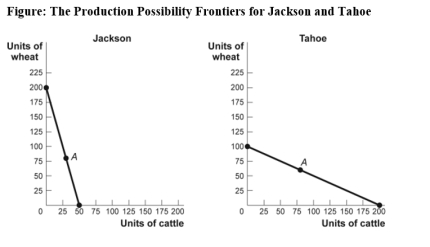Use the following to answer questions: 
-(Figure: The Production Possibility Frontiers for Jackson and Tahoe) Use Figure: The Production Possibility Frontiers for Jackson and Tahoe.In autarky,Jackson produces and consumes 30 head of cattle and 80 kilograms of wheat,while Tahoe produces and consumes 80 head of cattle and 60 kilograms of wheat.Each nation specializes completely,based on comparative advantage,and the price of 1 head of cattle equals the price of 2 kilograms of wheat.If Jackson exports 120 kilograms of wheat to Tahoe,then the new consumption point for Tahoe after trade is _____ kilograms of wheat and _____ head of cattle.
Definitions:
Vertical Integration
A strategy where a company expands its business operations into different steps on the same production path, such as when a manufacturer owns its supplier and/or distributor.
Singer Sewing Machines
A historically significant brand that played a key role in the development and mass production of sewing machines, changing the textile industry.
Indian Lands
Territories inhabited or historically owned by indigenous peoples of the Americas prior to European colonization and often the subject of conflict and negotiation thereafter.
Late Nineteenth Century
Refers to the period from around 1870 to 1900, marked by significant industrial, social, and political changes worldwide.
Q37: A firm is an organization that buys
Q75: The infant industry argument for trade protection
Q86: (Scenario: The Production of Wheat and Toys)Use
Q139: (Table: Peanut Butter and Jelly)Use Table: Peanut
Q147: Which statement is TRUE of an inferior
Q150: If Japan levies tariffs on Canadian goods
Q155: The GDP deflator is another name for
Q163: Inventory is counted as investment because it:<br>A)
Q174: A tariff imposed on Japanese imports into
Q210: Import tariffs always benefit domestic producers more